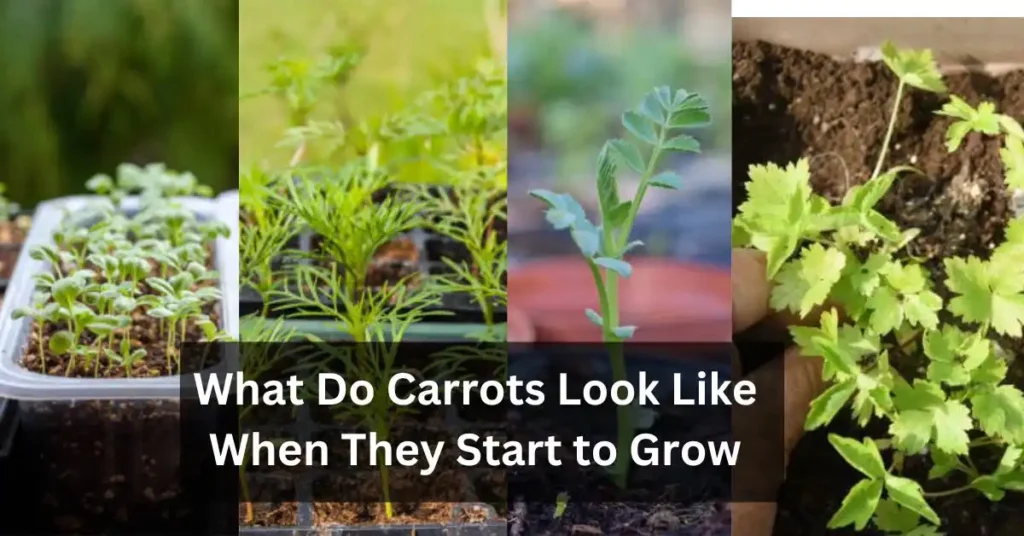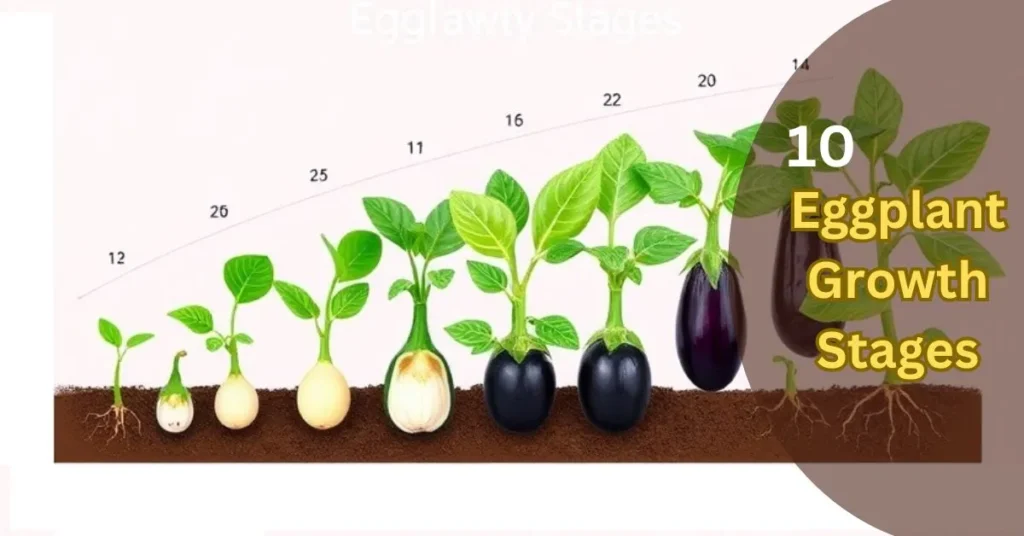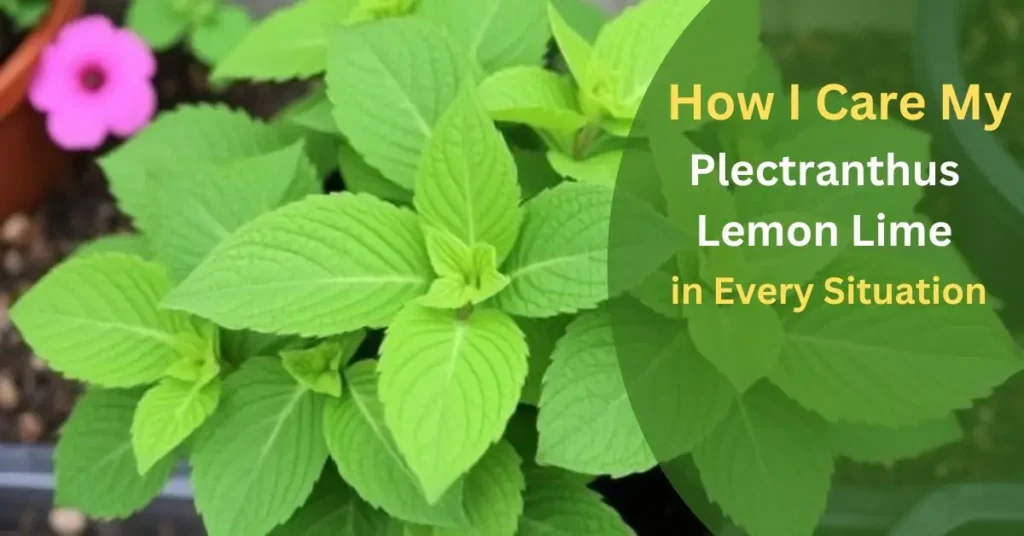When you plant a tiny seed, you might wonder what exactly happens under the soil as it starts to grow. At first, a carrot’s root begins to develop, but it’s not the familiar, vibrant orange shape you see on your dinner plates. The early stages of carrot growth involve the emergence of small green shoots that gradually rise above the ground.
Over time, these shoots become the leafy tops we associate with carrots, while below the surface, the root starts to develop and grow thicker. As the plant matures, the texture of the growing carrot changes, from soft and fragile to firmer and more solid.
In the fascinating process of carrot growth, the seed turns into a fully mature carrot ready for harvest. As it continues to mature, its color deepens, transforming into that crisp and vibrant orange hue that we all know and love.
It’s a true journey to watch this popular vegetable grow from a tiny seed to a delicious root ready to be enjoyed in countless ways. If you’re growing carrots in your own garden, it’s a rewarding experience to witness the plant’s steady growth, from its first sprout to the moment it’s ready to be picked and eaten.
Key Points
| #- | Key Point | Description |
|---|---|---|
| 1- | Seedling Appearance | Carrots start as small green shoots emerging from the soil. |
| 2- | First Leaves | The first leaves are feathery and thin, resembling small ferns. |
| 3- | Root Development | The carrot root starts to grow deeply into the soil, forming a taproot. |
| 4- | Leaf Growth | As the plant matures, the leaves grow taller and thicker, becoming bushy. |
| 5- | Color of Leaves | The leaves are typically bright green at the early stages. |
| 6- | Size of Root | The carrot root is initially small, thin, and light in color. |
| 7- | Shape of Root | The root starts to elongate and thicken as the carrot grows deeper into the soil. |
| 9- | Soil Visibility | Carrots start underground, so only the green leafy tops are visible at first. |
The Carrot Seed: Where It All Begins
Carrots begin their lives as lowly seeds. These small seeds, typically only a few millimeters in length, may seem unremarkable at first glance. They are often oval or cylindrical in shape, with a variety of colors, including shades of brown, black, white, and occasionally orange.
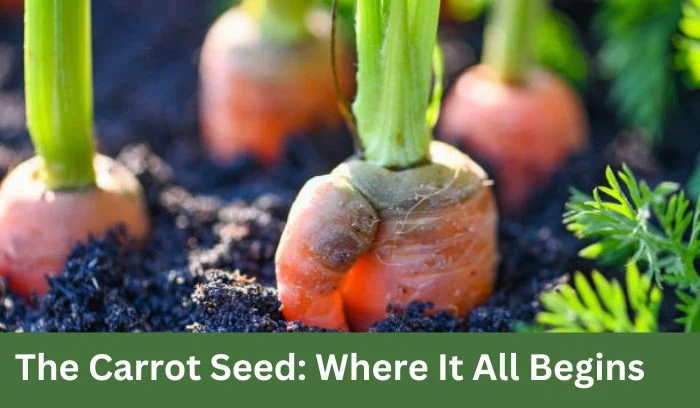
The seeds, in contrast to the vibrant orange hue of a fully grown carrot, exhibit a more subdued appearance and may not readily evoke the image of the vegetable they are destined to become. Despite their simple appearance, these seeds are packed with the potential to transform into a healthy, mature carrot.
In a garden or farm, planting a carrot seed is just the beginning of a fascinating process. Over time, these seeds grow into vibrant, leafy plants that eventually produce the vegetable we know and love.
It’s amazing how something as tiny as a small seed can give rise to such a wonderful and nutritious root. From a simple seed, the entire life cycle of the carrot unfolds, starting with its quiet beginnings and ending with a delicious vegetable ready for harvest.
Germination: From Seed to Seedling
When you plant carrot seeds, the first obvious sign of growth is the appearance of tiny green seedlings. This is the early stage of development, known as germination. During this exciting moment, gardeners eagerly watch for the tiny shoots pushing through the soil.
The seeds begin to absorb water and nutrients, and soon, they transform into little seedlings. This phase marks the beginning of the carrot’s life cycle.
As gardens begin to show signs of new growth, you can expect the tiny green sprouts to continue growing into healthy plants. The germination process is always an exciting time, as it signals the start of something much bigger—your carrots are on their way to becoming a full-grown vegetable!
Sprouting
Sprouting is the exciting next step after germination. Once you’ve planted carrot seeds, it usually takes about 7 to 14 days for them to sprout. The first thing you’ll notice is the appearance of small, slender green shoots pushing through the soil.
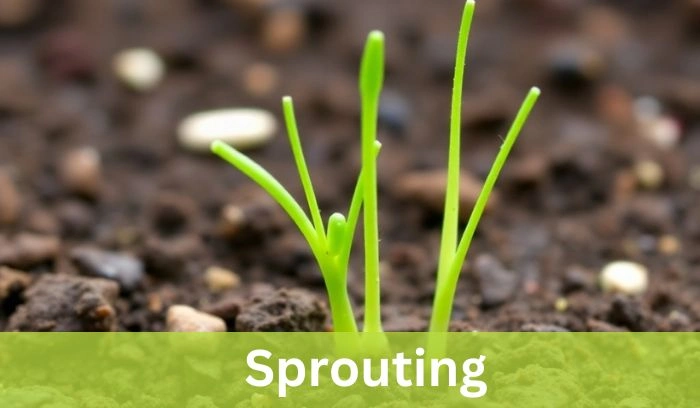
These little shoots are the beginning of the seedlings, marking the start of a new life for your carrot plant. The moment you see them breaking through the surface of the soil, you know that the sprouting phase has begun.
As the carrot seedlings grow, they will continue to stretch and strengthen, setting the stage for the next stages of development. It’s a truly fascinating process to witness, especially when those tiny shoots start to stand tall and strong, giving you a clear sign that your carrot plants are on their way to full growth.
Cotyledons
During the germination process, the first leaves that appear are called cotyledons. These leaves are not the true leaves of the plant but play an important role in providing the initial nutrients that the growing plant needs.
Carrot cotyledons are typically slender and have a bluish-green hue, making them look quite different from the typical feathery leaves that will develop later on. These early leaves are essential for the plant’s early survival but will eventually be replaced by the characteristic leaves of the mature carrot plant.
As the cotyledons fade away, the plant shifts its focus toward developing true leaves, which are more suited for photosynthesis and supporting the plant’s continued growth. The cotyledons mark the very beginning of the plant’s life cycle, serving as a vital step on its way to becoming the healthy, fully grown carrot that will be harvested later.
True Leaves
As the seedling develops, true leaves emerge, taking the place of the initial cotyledons. These true leaves are much more delicate and feathery, resembling the mature carrot leaves that will develop later.
At this stage, they take on a characteristic fern-like appearance, which makes them stand out from the earlier leaves. These early true leaves help the plant continue its development by improving its ability to capture sunlight and produce energy.
The true leaves of a carrot plant gradually grow larger and stronger, allowing the seedling to thrive. As the leaves take their final form, the plant is better prepared to grow into a healthy, mature vegetable. The transformation from cotyledons to true leaves marks an exciting step in the life cycle of the carrot, signaling its progress toward maturity.
Root Development: Getting to the Core of Carrots
As the carrot plant grows, a key transformation occurs below the soil. While the above-ground parts develop, the root starts to take shape, growing and thickening. This root is essential for storing nutrients and energy for the plant’s growth.
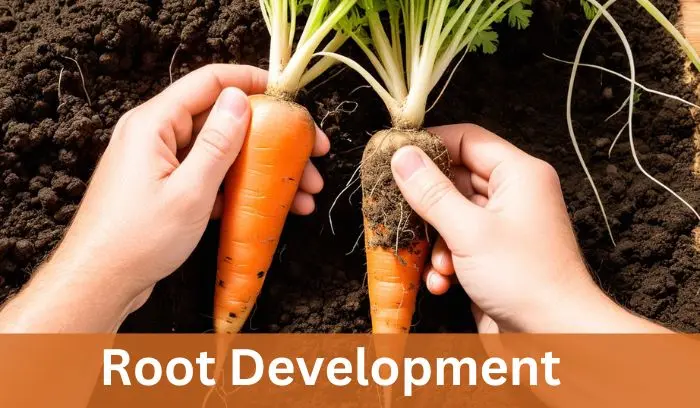
During this stage, the carrot root begins to resemble its characteristic appearance, expanding deeper into the soil. This hidden process is crucial for the plant’s development.
Primary Root
The primary root, also called the taproot, is the first to develop in carrots. It begins by growing straight down into the soil. As it grows, the root elongates and starts to take on the typical tapering shape of a carrot.
During the early stages, it is still quite small, but it marks the beginning of the root’s journey to becoming the long, tapering root we recognize. This first part of the root is critical as it anchors the plant and begins to absorb nutrients, helping the carrot grow stronger.
As the root develops, it becomes the primary anchor of the plant, taking on a more distinct form. The tapering structure becomes more pronounced, and the root slowly matures into the familiar carrot shape. It’s fascinating to watch this early development, knowing it’s just the beginning of a journey that will take the root deeper into the soil, where it will continue to grow and thrive.
Secondary Roots
As the primary roots grow, smaller secondary roots begin to develop alongside them. These secondary roots are thinner and less developed compared to the main taproot. They play a crucial role in helping the plant anchor itself into the soil and are essential for the absorption of water and nutrients.
Although these roots are not as prominent as the primary roots, they are vital for the plant’s growth as they continue to spread and strengthen over time.
At this stage, the secondary roots are crucial for the plant’s stability, ensuring that it has a strong foundation in the soil. While they are still smaller and thinner, they will eventually grow larger and become more robust as the plant matures. This development allows the plant to thrive and absorb more resources from the soil, supporting further growth.
Early Growth Stages: Recognizing Young Carrot Plants
In the early stages of growth, young carrot plants can look quite different from the mature carrots we’re used to. At this point, they may not have the familiar orange shape or size, but they still display certain characteristics that make them easy to identify as carrots. These young plants usually have slender green shoots that grow straight up from the soil.
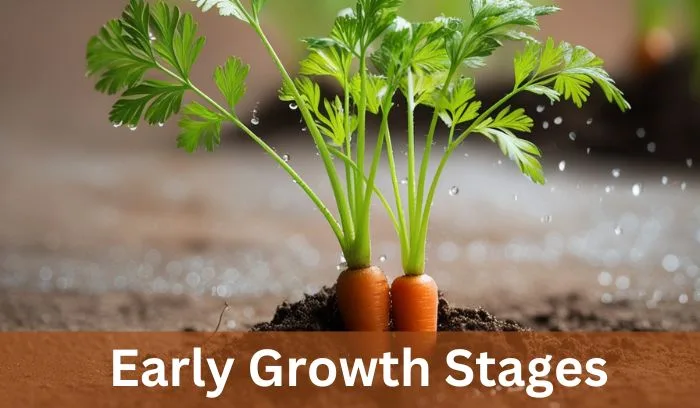
As the plant continues to grow, you will start to see the characteristics that set carrots apart from other plants. Even though the young plants are still small and in their early stage, their unique features will gradually help you recognize them, making it easier to care for them as they develop into mature carrots.
Leaves
As the carrot plant matures, its leaves become more distinct and noticeable. Initially, these leaves are small, but as they grow, they develop a feathery texture, with many narrow segments that make them stand out. The fresh green color of the leaves is a clear indicator of the plant’s health, and the overall appearance is delicate yet vibrant.
The more you observe, the easier it becomes to identify the plant as it starts to resemble a carrot, even in its early stages. In the early stages of growth, the leaves may seem quite simple, but over time, they transform into a characteristic pattern that distinguishes carrot plants from other vegetables.
The combination of green color, feathery texture, and divided segments gives the plant a unique look. As it continues to grow, the leaves become even more distinct, signaling the plant’s progression from a seedling to a fully-developed carrot.
Carrot Shape
When observing young carrot plants, you can spot early signs of the plant’s growth through the shape of the developing root. At this initial stage, the taproot begins to elongate and gradually tapers. Though it’s far from the plump, mature carrot you’ll see later, the subtle hints of its final form start to emerge.
The root development is still in its early phase, with the carrot plant focusing on root growth and structure. You won’t yet see a fully developed carrot; instead, the plant is working on its root elongation and forming the groundwork for a strong foundation in the soil.
This early growth process is essential for the plant’s future success. As the carrot growth progresses, the root starts to show clear signs of becoming more defined. Even though the carrot characteristics aren’t fully visible, the early growth stages reveal important growth indicators that show how the carrot plant is maturing.
It’s at this point when careful attention is needed to ensure the plant receives optimal care for its continued vegetable growth. With time, the young carrot will transition through these growth stages, ultimately reaching its mature, edible form.
Mid-Season Growth: Carrots Begin to Take Shape
As the carrot plant moves into the mid-season growth phase, you’ll notice some key changes. The root development accelerates, and the primary root continues to elongate, while secondary roots become more prominent.
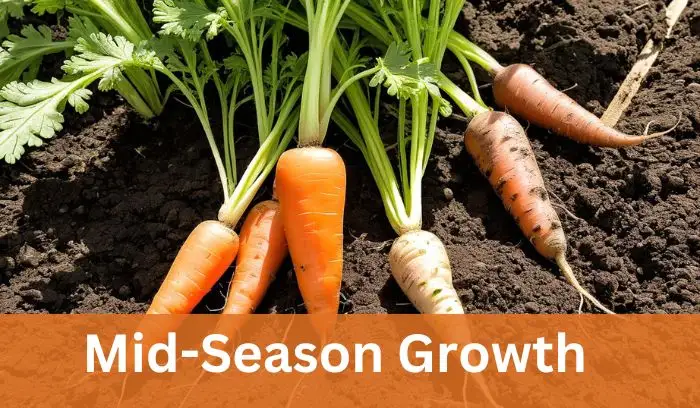
This is when the carrot shape starts to take form, as the root begins to fill out, becoming thicker and taking on a more cylindrical shape. The color gradually shifts from white to a soft pale orange, though it’s still far from the rich, vibrant orange seen in fully mature carrots.
In addition to the root changes, the leaf growth also plays an important role. The feathery leaves continue to expand, offering more surface area for photosynthesis, which is essential for the plant’s overall growth.
Healthy leaves are vital for supporting the carrot’s development as it continues through this growth stage. The plant’s ability to convert sunlight into energy directly impacts the size and quality of the carrot that will eventually reach its mature form.
What Do Carrots Look Like When They First Start Growing?
When carrot seedlings first begin to emerge, they appear as small, bright green shoots. These young plants are slender and have an upright growth pattern. The leaves of these seedlings are delicate and have feathery foliage.
At this stage, the seedlings resemble tiny blades of grass, with the ferns-like texture becoming more pronounced as they grow. As the plants develop, the leaves become finely divided with lacy edges, giving them a more mature and recognizable appearance.
I have noticed how quickly these tiny seedlings grow, and it’s fascinating to watch them change over time. From their first appearance, they are already characterized by their unique texture and delicate features. It’s truly a joy to see them transform into healthy plants with vibrant foliage.
Mature Carrots: Ready for Harvest
Carrots are ready for harvest when they reach full maturity, which depends on carrot variety, growing conditions, and personal preferences. At this stage, mature carrots will have the right size, flavor, and appearance. The growth stage will be complete, and the carrots will be perfectly edible with the ideal taste and ripeness.
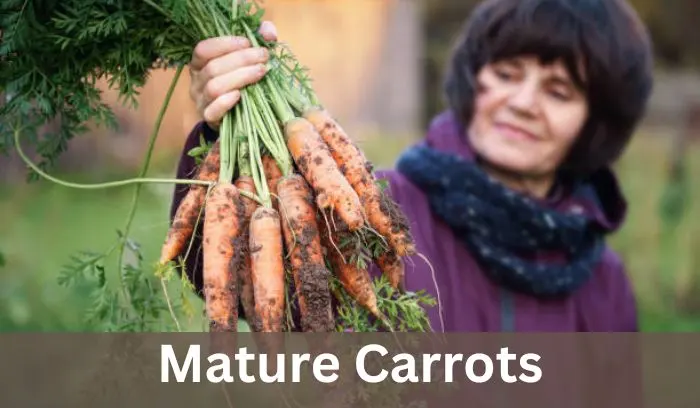
The best time for harvest is when the crop has reached its peak maturity. Factors like soil, season, and plant health will determine when your carrots are ready. Once harvested, you’ll enjoy the perfect balance of vegetable growth and flavor in your garden.
Carrot Size
As carrots reach their mature form, they grow much larger than when they first began growing. At this point, the carrot has reached its full size, with the desired length and thickness specific to the variety you planted.
You’ll notice the growth progress in both the root growth and the plant size, which have developed significantly during the growth cycle. Depending on the variety, there can be some size variation, but mature carrots should always meet your expectations for appearance and edibility.
By the time harvest comes around, the carrot will be ready for picking, showing off its ripeness and perfectly shaped root. This is when you can observe the final form of the crop. Whether it’s the classic vegetable or a different variety, the growth stage will determine when it’s ideal for harvesting. Keep an eye on the vegetable growth to make sure the carrot characteristics align with the optimal harvest time.
Color
The vibrant orange shade of mature carrots has always fascinated me. It’s not just about the typical orange; some varieties surprise you with shades of purple, red, yellow, or even white. Each color tells its story, tied to the intense hue that these carrots develop as they grow.
This transformation owes its beauty to the accumulation of carotenoid pigments, particularly beta-carotene, which gives the classic orange color its striking appeal.
I remember pulling a bunch of carrots from my garden last summer and marveling at the vibrant tones they displayed. The different hues make every harvest feel like uncovering nature’s palette. These colors are not just visual treats but a sign of the richness within, as they highlight the natural compounds like carotenoids, adding depth to every bite.
Root Shape
When mature carrots are ready for harvest, their fully developed and elongated shape catches the eye. The way the tapering tip forms signals their readiness, making them easy to identify. The taproot stands out as it becomes plump and firm, a sign that the carrots are prime for pulling from the soil.
I still remember the satisfying feeling of gently pulling a ready carrot, its smooth texture showing it had reached the perfect shape. The balance of the plump body with its tapering tip reveals the hard work hidden in the soil, a rewarding sight for any gardener.
Top Growth
The leaves of a mature carrot are a clear sign of its readiness. These lush, green plants not only make a garden look vibrant but also play a crucial role in the growth process. As the root grows, the leaves provide energy, ensuring that the carrot reaches its peak condition.
I’ve noticed how these plants thrive when properly cared for, storing natural sugars in the root to enhance flavor and nutrition. Watching a mature carrot develop its sturdy leaves is a rewarding experience that highlights the connection between what happens above and below the soi.
Signs of Healthy Carrot Plants
When growing carrots, it’s important to look for signs that indicate your plants are thriving. Healthy carrots typically have a strong taproot that is firm and smooth, free of any discoloration or mushiness. The secondary roots should be thin and fibrous, helping to ensure strong growth.
For the best plant development, carrots need consistent moisture, which contributes to their sweet taste and tender texture. If you perform a shoulder test and the shoulder of the carrot is around 3/4 to 1 inch in diameter, this means the carrot is ready to harvest. Additionally, the carrot greens above the soil should be about 10 to 12 inches tall, and the stems should be thick and healthy.
Other key indicators include the plant not showing any wilting or reduced growth, both of which can signal issues with the soil or moisture. Healthy carrot plants will have plenty of green growth and will be able to withstand environmental stress, ensuring a good harvest with no signs of damage. Keep an eye on the topsoil for carrot growth and ensure that the plants receive enough care for optimal development and signs of vitality.
What Is The Best Soil For Carrots?
The best soil for carrots is a light, sandy loam that provides good drainage. Carrots need fertile soil that is rich in organic matter to grow healthy roots. It should have a slightly acidic to neutral pH range of 6.0 to 6.5, which helps in optimal carrot growth.

A well-drained soil will ensure that the carrots develop their deep root system without encountering stones or compacted clay, which can hinder their growth. The soil should be loose enough to allow the roots to grow straight and deep, providing ample space for the full length of the carrot root.
If your soil isn’t ideal, you can amend it with compost or well-rotted manure to improve soil texture and nutrients. For heavy clay soils, mix in some sand to improve drainage.
It’s also important to test your soil’s pH level using a soil test kit and adjust it if needed with lime to raise the pH or sulfur to lower it. Adding aged manure or additional organic matter will further enhance the soil fertility, ensuring your carrots grow strong and healthy.
How Do Carrot Sprouts Look Different From Grass
When carrot sprouts first emerge, they can easily be confused with grass because of their similar appearance. However, there are a few key differences. Grass typically has narrow blades, while carrot sprouts have more broad leaves.
The stems of grass stay close to the ground, whereas carrot sprouts extend upward. Grass often grows in clusters, but carrots grow in rows if you’ve planted them that way, especially when broadcast sowing isn’t involved.
One of the simplest ways to tell the difference is to rub the sprouts between your fingers. Doing so will release a distinctive scent. Carrot sprouts will smell like a real carrot, while grass has a familiar, grassy smell. This sensory trick is a great way to quickly tell them apart, especially when you’re unsure whether you’re dealing with carrot sprouts or grass sprouts.
Signs of Healthy Carrot Plants
6 Useful Carrot Cultivation Tips
Growing carrots successfully requires understanding their specific needs. It hinges on the right soil and proper conditions. Climatic environments also play a vital role in their development. To ensure a bountiful harvest, it’s important to prepare the soil properly, providing enough space and the right temperature for the roots to grow.
One of the essential steps in growing carrots is ensuring the right moisture levels. Without this, your crop may not grow to its full potential. Understanding these factors and being patient will help you maximize the yield. Whether you are a beginner or an experienced gardener, knowing the appropriate steps to take will lead to a successful carrot harvest.
1. Soil Preparation
To grow healthy carrots, you need to start with fertile, well-drained soil. The soil should be deep, sandy, and loose, with a fluffy texture. It is essential that the pH of the soil is between 6.0 and 7.0 for optimal growth. A great way to improve the soil is by double-digging it and adding organic matter, such as compost, which will help to enhance root development.
Before planting, it’s also important to do a soil test to understand your soil’s nutrient levels. Based on the test report, you can get accurate fertilizer recommendations to ensure your carrots grow strong and healthy. Proper soil preparation is the key to a successful carrot crop.
2. Fertilization
When growing carrots, the key to healthy growth is careful fertilization. About 6 weeks after seed emergence, it’s time to apply a ¼ cup of nitrogen-based fertilizer like 21-0-0 per 10 feet of row. This will promote rapid plant growth and support the development of strong roots.
However, be mindful to avoid excessive nitrogen, as too much can lead to excessive foliage instead of proper root development. Balancing the nutrients at the right time is essential for achieving the best results in your carrot crop.
3. Water Management
For carrots to thrive, it’s crucial to ensure they are watered regularly, especially in sandy soils where moisture can fluctuate quickly. It is essential to strive for consistently moist soil conditions while avoiding excessive watering, as this can result in issues such as root disorders, forking, and the development of hairy roots. Maintaining the right balance of water is key to successful carrot growth.
Using drip irrigation is an effective method to keep moisture levels consistent. This technique helps prevent the soil from drying out while ensuring that the carrots receive just the right amount of water, avoiding both under-watering and over-watering.
4. Spacing and Thinning
When planting seeds, it’s important to sow them about ¼ inch deep. As soon as the seedlings start to produce their true leaves, it is necessary to thin them out. Ensure you space the plants 3-4 inches apart to allow each one enough room to grow.
Proper spacing is critical because it promotes air circulation and ensures nutrient availability for each plant, both of which are essential for healthy growth and development. By following these steps, you’ll help your plants thrive and avoid overcrowding, which could stunt their growth.
Tips for Carrot Thinning and Spacing
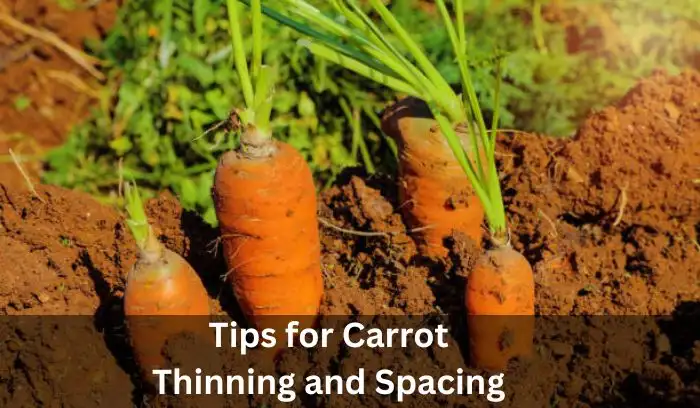
| Topic | Details |
|---|---|
| When to Thin | Thin carrots when they are about 3–4 inches tall, and thin again about a month later. |
| How Much Space to Leave | Space carrots 1–2 inches apart, depending on variety and size of the carrots. |
| What to Remove | Remove the smallest, weakest, and scrawniest plants or those growing on top of each other. |
| How to Thin | Water seedlings before pulling, and grip the seedling between thumb and forefinger to avoid breaking the roots. |
| What to Do with Removed Carrots | The baby carrots you remove are edible and can be used in salads or as a garnish. |
| Why to Thin | Thinning is crucial for carrots to reach maturity. Without space, their roots will remain small and puny. |
| How to Space Rows | Maintain 12 inches between rows, with 18 inches being ideal, depending on the carrot’s top height. |
5. Temperature and Climate Conditions
For optimal growth, carrots thrive in a temperature range of 40-80°F. However, high summer temperatures above 80°F can reduce seed germination, affecting the overall crop yield.
On the other hand, temperatures dropping below 32°F can cause significant damage to the plants, even freezing them. In regions with strong direct sunlight, partial shade can be beneficial to prevent overheating and protect the carrots from extreme heat, ensuring they continue to grow steadily.
6. Mulching
Mulching is a great way to improve garden health. Using organic mulch such as sawdust, straw, pine needles, or leaf mold can help conserve soil moisture. It also maintains soil temperatures by keeping them even, which is important for plant growth. One of the best benefits is how it reduces weed pressure, preventing unwanted plants from taking over your garden space.
Another advantage of mulching is that it minimizes moisture fluctuations that often happen in unevenly watered gardens. With mulch, your garden stays more consistent in its moisture levels, making it easier to care for plants. This simple yet effective method helps create a healthier environment for your garden to thrive.
How Long Do Carrots Take To Grow From Seed?
Carrots generally take 55–100 days to grow from seed, depending on the variety and other factors. The time to harvest for most carrots is around 60–80 days after sowing, when the roots mature and start to size up. Different varieties of carrots have varying maturation times.
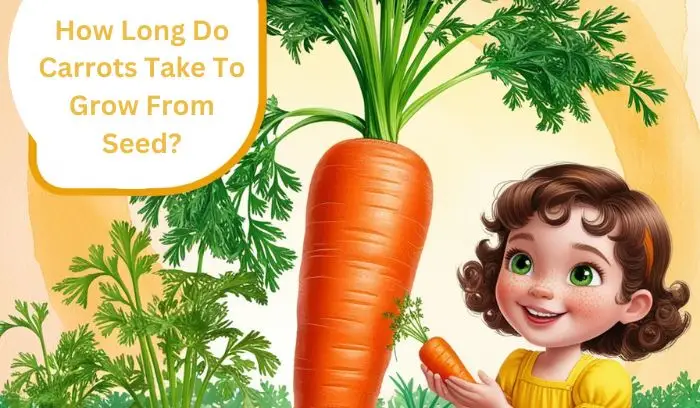
The Danvers variety requires a maturation period of 65 to 75 days, whereas the Dragon variety takes between 70 and 90 days to reach maturity. Planting carrot seeds should occur about 2–4 weeks before the last frost, ensuring the soil temperature is cool for good germination.
Carrot Growing Information
| Carrot Variety | Maturation Time | Harvest Time | Planting Time | Soil Temperature |
|---|---|---|---|---|
| Danvers | 65–75 days | 60–80 days | 2–4 weeks before last frost | Cool (below 75°F) |
| Dragon | 70–90 days | 60–80 days | 2–4 weeks before last frost | Cool (below 75°F) |
| General | 55–100 days | 60–80 days | 2–4 weeks before last frost | Cool (below 75°F) |
Carrot Varieties and Their Benefits

Orange Carrots: Nutrient Powerhouses
Orange carrots are rich in beta-carotene, which the body converts into vitamin A, an essential nutrient that plays a key role in vision support. This powerful carotenoid also promotes skin health and boosts the immune system, making it an important part of any balanced diet.
The orange color of these carrots comes from their high content of beta-carotene and other beneficial nutrients, which make them a go-to vegetable for overall health benefits. Vitamin C, also found in orange carrots, helps prevent cell damage, providing cell protection and supporting the body’s natural defense mechanisms.
These carrots are not just about flavor; they’re nutrient-rich and packed with antioxidants that support immune health and wellness. The combination of antioxidant properties and essential vitamins in orange carrots helps maintain the body’s functions, while also providing much-needed nourishment.
Incorporating these carrots into your diet ensures that you get a solid dose of dietary benefits, such as improved vision, stronger skin, and enhanced immunity. Whether in salads, juices, or cooked dishes, orange carrots offer a simple yet effective way to boost your health-related nutrition.
Yellow Carrots: A Nutrient Boost for Eye Health
Yellow carrots are packed with xanthophylls, a type of carotenoid that contributes to their vibrant color. These carotenoids have powerful antioxidant properties that help promote overall eye health.
Eating yellow carrots regularly can support vision and even help reduce the risk of age-related macular degeneration, a common eye condition. In addition to their eye benefits, these carrots are also rich in other essential nutrients and have health benefits that support wellness.
What makes yellow carrots stand out is their ability to improve macular health and provide visual wellness. The carotenoid pigments in these carrots provide eye protection, reduce the effects of aging on vision, and offer macular protection.
With their rich nutrient content and protective benefits, yellow carrots are a great addition to any diet, especially for those concerned about eye care and maintaining strong vision over time.
Red Carrots: A Nutritional Treasure
When I first discovered red carrots, I was amazed by their vibrant color and unique taste. These carrots aren’t just visually appealing—they pack a punch of nutrition. Rich in lycopene, a powerful carotenoid, they stand out for their ability to reduce the risk of serious health concerns. Adding red carrots to your meals isn’t just a treat for the eyes; it’s a step toward better health.
Scientific studies suggest that lycopene plays a vital role in protecting against cancers and supporting heart health. This nutrient works hard to shield your body from disease, making red carrots an ideal choice for those looking to boost their overall well-being. Incorporating them into soups, salads, or even juices is an effortless way to enjoy their benefits daily.
The Unique Charm of Purple Carrots
When I first tried purple carrots, I was struck by their deep color and slightly sweet taste. But their beauty isn’t just skin deep—these carrots are loaded with anthocyanins, natural compounds that provide their signature hue. Known for their strong antioxidant properties, these carrots are a powerhouse of nutrition.
Adding purple carrots to your diet can help reduce inflammation and improve heart health. Their unique composition works to shield the body from damage and promote overall well-being. Whether in salads, roasted, or blended into juices, these vibrant carrots are as versatile as they are healthy.
How To Save Carrot Seeds
To save carrot seeds, start by waiting until the second year. During the first year, the plant grows the edible root, and in the second year, it produces a tall stalk with flowers that eventually turn into seed heads. Once the seed heads have fully ripened and dried, carefully cut them off and place them in a paper bag.
Separate the seeds from the chaff by gently crushing the heads inside the bag or using a sieve, colander, or mesh. Next, place the seeds on a paper towel or a screen, allowing them to dry naturally in a warm, dry location for several days.
Once the seeds have dried, keep them in an airtight container, such as a glass jar or plastic bag. Make sure to label the container with the date and type of seed, then store it in a cool place, ideally below 15 °C.
How To Store Harvested Carrots
When storing harvested carrots, it’s important to take a few simple steps to keep them fresh. First, remove the greens by cutting off the tops about ¼ to ½ inch above the root shoulders, as they can draw moisture from the carrots. Next, place the carrots in a dry, airy space to allow them to dry and cure slightly.
After that, store the carrots in an airtight container or a bag, and you can even wrap them in newspaper for extra protection.For long-term storage, place the carrots in the fridge’s crisper drawer.
Keep them away from fruits like apples and bananas since they release ethylene gas, which can cause the carrots to spoil faster. Be sure to check the carrots monthly for any signs of decay, such as fine root hairs. If you notice any, simply remove them. Properly stored, carrots can last up to two to three months in the refrigerator.
Common Carrot Growing Mistakes and How to Avoid Them

Soil Conditions for Healthy Carrots
One prevalent error in cultivating carrots is overlooking the condition of the soil. Heavy clay soils can seriously prevent carrots from forming properly, resulting in poor, underdeveloped roots.
From my personal experience, it’s essential to focus on the structure of the soil. To achieve better good-sized roots, the soil must be well-draining and loose enough to allow the roots to expand. Adding sand or well-rotted compost is a great way to improve the soil’s texture, ensuring that it’s neither too compact nor too sandy.
Also, keeping the pH level of the soil between 6.0 and 6.5 is key for optimal carrot growth. If the pH is too high or low, it can affect the ability of the plants to absorb necessary nutrients. Ensuring a balanced pH helps carrots grow efficiently, yielding those crisp, healthy roots everyone loves.
Watering Carrots the Right Way
One of the most common mistakes when growing carrots is not getting the watering right. These vegetables need regular watering, but not too much or too little. Carrots are made up of about 88% water, so ensuring they receive enough moisture is critical.
Typically, 1-2 inches of water per week is ideal, but this can change depending on weather conditions. During hot periods or in sandy soil, you may need to water more frequently to keep the soil consistently moist. Too much water can lead to root rot, while too little can cause the carrots to become misshapen or poorly developed. Finding the balance in watering is key to growing healthy, robust carrots.
Choosing the Right Companion Plants
When growing carrots, it’s important to be mindful of the companion plants around them. For example, it’s best to avoid planting dill or fennel near carrots, as they can stunt the growth of the carrots.
These plants can also attract pests that may harm your carrot crop. I’ve learned through experience that careful planning of which plants are placed together can make a huge difference in the health and yield of your garden. By choosing the right companions, you can help your carrots grow strong and free from pests.
Managing Pests in Carrot Gardens
Pests can cause significant damage to your carrots if not controlled early. Some of the common pests that target carrots include carrot flies, aphids, and cutworms. From my experience, these pests can stunt growth and affect the quality of your harvest.
It’s important to be proactive and take steps like using organic pest repellents or setting up barriers to keep these pests at bay. Regularly checking your plants for signs of damage is a simple but effective way to catch problems before they escalate.
Planting Carrots at the Right Time
Planting early varieties of carrots is essential for getting a head start on the growing season. You can sown them as early as February or March, but to ensure their protection against the cold, cover them with cloches or fleece.
From personal experience, planting carrots too late or without proper protection can lead to slower growth or even failure to sprout. By taking these early steps, you can give your carrots the best chance to thrive in the warmer months.
Managing Nitrogen Levels in the Soil
When growing carrots, too much nitrogen in the soil can lead to large, lush green carrot tops, but the roots may not develop properly. This imbalance can cause the plant to focus on growing the leaves instead of building a strong root system.
In my experience, ensuring that nitrogen levels are not excessively high is key to getting the best quality carrots. Using a balanced fertilizer and keeping an eye on the soil’s health can help prevent this issue, allowing the roots to grow thick and healthy.
Fertilizer: Essential for Healthy Carrot Growth
When growing carrots, one of the biggest mistakes is neglecting to assess your soil’s fertility before planting. To ensure the best growth and root development, it’s crucial to determine the nutrient needs of your soil.
A soil test helps you understand the current nutrient levels, whether it’s nitrogen, phosphorus, or potassium. Testing the soil before planting allows you to make necessary adjustments by adding soil amendments like organic matter or inorganic fertilizers. Working these nutrients into the top 6 inches of soil ensures they reach the topsoil, where carrot roots need them most.
Don’t forget that proper moisture retention and drainage are key to a healthy root system. Applying fertilizers incorrectly, without mixing or preparing the soil properly, can result in poor crop yield and might cause nutrient deficiency that hampers your carrot’s health.
Pre-planting is a great time to incorporate soil amendments, which can improve the texture and structure of your garden beds. By focusing on good plant nutrition with the right balance of micronutrients, you promote sustainable gardening practices that lead to better harvests.
Many gardeners, including myself, have learned the hard way that skipping this crucial step can harm carrot growth. Always ensure your soil is well-prepared for planting to optimize vegetable improvement and maintain long-term farming success.
Protecting Carrots from Sunburn
One of the most common mistakes when growing carrots is not protecting them from sunburning. This happens when the roots start swelling and exposure to direct sunlight causes the carrot tops to turn green. To avoid this, you can practice mounding soil around the row to create a covering that shields the roots from harmful sunlight.
This will not only protect them from sun damage but also help with moisture retention and ensure better growth. If you don’t provide adequate protection, the carrots might suffer from environmental stress, affecting their development and reducing the yield.
Proper temperature control and maintaining a consistent soil level are also essential for preventing sunburning. It’s important to take into account the texture of the soil and ensure that the carrots have enough coverage to avoid injury from excessive sun exposure.
By using good garden practices like organic gardening techniques and proper crop management, you can ensure your carrot production remains healthy and yields the best results, free from sunlight damage.
Dealing with Root-Knot Nematodes
One common mistake when growing carrots is ignoring the presence of root-knot nematodes, which can cause significant damage to your crop. These pests attack the roots, leading to stunted growth and reduced yield. To avoid this, it’s essential to perform a soil test to verify if nematodes are present. If detected, you can treat the soil with heat, using plastic sheeting to trap the sun’s warmth during the summer months, which can effectively kill the nematodes. This method is part of sustainable farming and offers an organic approach to pest control, minimizing the use of chemicals.
Proper pest management is key to maintaining crop health. Besides nematode control, other agricultural methods like temperature control and improving soil care can further help prevent future infestations.
This combination of prevention and treatment not only protects your carrots but also promotes better plant health and improvement in overall yield. Using these techniques ensures that you grow carrots free from the damaging effects of nematodes and other pests, improving the long-term health of your garden.
FAQs
Carrots generally require a growth period of 60 to 80 days, which can vary based on the specific variety and the level of care they receive. Plant them in loose garden soil and thin seedlings at the seedling stage for the best results. After 60-80 days, they should be ready for harvest, with growth time varying based on weather and conditions.
Carrots are usually vibrant orange, but they can also be purple, red, yellow, or white. The intense hue comes from carotenoid pigments like beta-carotene. Mature carrots have an elongated shape with a tapering tip and a smooth root shape.
Carrots stand out due to their distinguishing features like the vibrant orange color and elongated shape. Their qualities, including a crunchy texture and slightly sweet flavor, make them easy to identify. Much like a chameleon, they have unique characteristics that set them apart from other vegetables. These simple features make carrots instantly recognizable in any garden.
Carrots are a great source of beta-carotene, which is good for eyesight and skin health. They are packed with fiber, which helps with digestion, and provide vitamin C, potassium, and vitamin B6 to support overall health. In addition, carrots offer calcium and magnesium, which help maintain strong bones and a healthy heart.
Conclusion
When tiny seeds are planted, it can be hard to imagine the vibrant, crunchy root vegetables that will eventually grow. In the initial stages of growth, the young plants may not look like the mature carrots we are used to.
As the plant develops, it starts to show more of its characteristic features, and soon enough, the recognizable green tops and long, orange roots become more prominent. The journey from tiny seed to mature vegetable is a fascinating journey for any gardener.
With proper care, including good soil preparation, and paying attention to potential challenges, even a beginner can enjoy the delightful process of growing fresh, homegrown produce. Whether you are an experienced gardener or just starting, the joy of growing carrots from farm to table is a satisfying experience. The right amount of effort will lead to a successful crop that’s as rewarding as it is tasty.
See Also:
How to Grow Plants Along a Vinyl Fence: Step-by-Step Guide
When to Seed Lemongrass in Zone 9a? A Complete Guide

